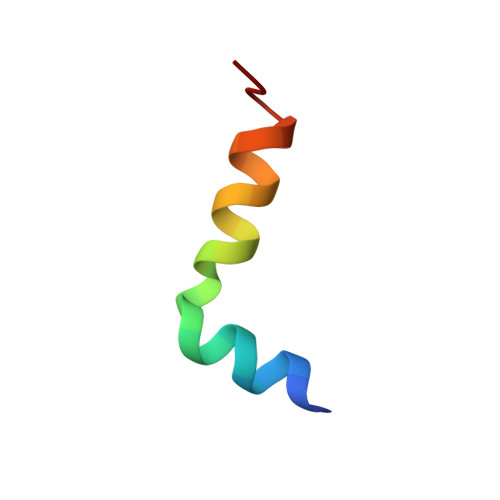Spatial structure and activity mechanism of a novel spider antimicrobial peptide.
Dubovskii, P.V., Volynsky, P.E., Polyansky, A.A., Chupin, V.V., Efremov, R.G., Arseniev, A.S.(2006) Biochemistry 45: 10759-10767
- PubMed: 16939228
- DOI: https://doi.org/10.1021/bi060635w
- Primary Citation of Related Structures:
2G9P - PubMed Abstract:
Latarcins (Ltc), linear peptides (ca. 25 amino acid long) isolated from the venom of the Lachesana tarabaevi spider, exhibit a broad-spectrum antibacterial activity, most likely acting on the bacterial plasmatic membrane. We study the structure-activity relationships in the series of these compounds. At the first stage, we investigated the spatial structure of one of the peptides, Ltc2a, and its mode of membrane perturbation. This was done by a combination of experimental and theoretical methods. The approach includes (i) structural study of the peptide by CD spectroscopy in phospholipid liposomes and by (1)H NMR in detergent micelles, (ii) determination of the effect on the liposomes by a dye leakage fluorescent assay and (31)P NMR spectroscopy, (iii) refinement of the NMR-derived spatial structure via Monte Carlo simulations in an implicit water-octanol slab, and (iv) calculation of the molecular hydrophobicity potential. The molecule of Ltc2a was found to consist of two helical regions (residues 3-9 and 13-21) connected via a poorly ordered fragment. The effect of the peptide on the liposomes suggests the carpet mechanism of the membrane deterioration. This is also supported by the analysis of hydrophobic/hydrophilic characteristics of Ltc2a and homologous antimicrobial peptides. These peptides exhibiting a helix-hinge-helix structural motif are characterized by a distinct and feebly marked amphiphilicity of their N- and C-terminal helices, respectively, and by a hydrophobicity gradient along the peptide chain. The approach we suggested may be useful in studying not only other latarcins but also a wider class of membrane-active peptides.
Organizational Affiliation:
Shemyakin-Ovchinnikov Institute of Bioorganic Chemistry, 16/10 Miklukho Maklaya str., Moscow, 117997 Russia.














